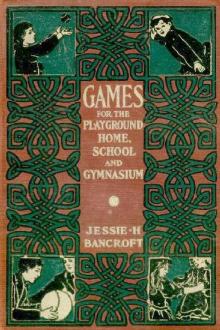Games for the Playground, Home, School and Gymnasium by Jessie Hubbell Bancroft (top novels of all time .txt) 📕

- Author: Jessie Hubbell Bancroft
- Performer: -
Book online «Games for the Playground, Home, School and Gymnasium by Jessie Hubbell Bancroft (top novels of all time .txt) 📕». Author Jessie Hubbell Bancroft
The teacher starts the game by tossing the ball to each pupil in turn, and it is immediately tossed back to her. Each pupil missing goes to the foot of the line. If the teacher misses, the player at the head of the line takes her place, the teacher going to the foot. The action should be as rapid as possible.
VAULTING RELAY10 to 60 players.
Schoolroom.
Bean Bags.
The players stand in line in the aisles between the desks, all facing to the right or left (facing open windows preferred). The first player at the front of each line will hold a bean bag in his right hand, if facing left, or in his left hand, if facing right. At the command "Start!" the bean bag must be passed toward the rear to each player, in turn, until the player at the end of the line receives it. Each player, after passing the bean bag, must place one hand on his desk and the other on the back of his chair, jump over his chair, turn, jump back again, and take his position in the aisle by the next seat, moving back one seat toward the rear of the line each time the bean bag has been passed, and so on until he returns to his place in line. The player receiving the bean bag at the end of the line must run to the head of the line, as shown in the diagram, and pass the bag to the next player. This continues until each player returns to his place in line. The line wins whose original leader first gets back to his own place.
This game was originated by Mr. James J. Jardine, of New York City, and received honorable mention in a competition for schoolroom games conducted by the Girls' Branch of the Public Schools Athletic League of New York City in 1906. It is here published by the kind permission of the author, and of the Girls' Branch, and of Messrs. A. G. Spalding & Brothers, publishers of the handbook in which the game first appeared.
BALL GAMES SUITABLE FOR BEAN BAGS All run Arch Ball Ball Chase Ball Puss Ball Tag Call Ball Center Catch Ball Circle Ball Club Bowls Center Club Bowls Circle Club Bowls Line Club Bowls (Single) Line Club Bowls (Double) Corner Spry Dead Ball Dodge Ball Home Run Line Ball Over and Under Relay Overtake Pig in a Hole Ring Call Ball Roley Poley Round Ball Russian Hole Ball Schoolroom Dodge Ball Spud Stride Ball Toss Ball Tree Ball Zigzag Games Circle Zigzag Line Zigzag I, II, III Zigzag Overhead Toss BALL GAMES BALL GAMES ALL RUN10 to 30 or more players.
Playground; gymnasium.
Hand ball; bean bag.
This game is played with a hand ball or basket ball and is a gymnasium adaptation of the wall ball game known as "Burley Whush" or "Ball Stand."
A square is drawn on the ground or floor. All of the players gather within this, including one who holds the ball. The ball man throws the ball in the air, whereupon all of the other players run in any direction as far as they can. The thrower remains on his place, catches the ball, and as he does so cries "Hold!" Upon hearing this, all of the others must instantly stop running. The thrower then aims his ball at one of these other players, and if he succeeds in hitting him, the player hit must change places with the thrower. Should he miss, all of the players return to the square and the same thrower takes another trial. Should he miss hitting a player a second time, he must be "court-martialed," i.e. stand twenty feet from the square with his back turned to the players congregated there, who pelt him with their balls, each one having one throw.
ARCH BALL10 to 100 players.
Playground; gymnasium; schoolroom.
Basket ball; bean bag; oat sack; any substitute.
This game is very similar to Pass Ball, but is here described under another name, as it differs from Pass Ball in (1) not having the run to a goal line; (2) admitting of variations, as in the passing of several articles; (3) being comparatively informal without the scoring of fouls and other strict observance of rules that class Pass Ball with athletic events.
The players line up in two or more single files, which compete with each other, and must therefore contain an equal number of players. The captain or leader of each file toes a line drawn across the ground and holds a basket ball (a bean bag or other object may be used). At a given signal he passes the ball backward over his head to the player next behind, who in turn passes it backward as rapidly as possible, and so on until it reaches the last player in the line. He at once runs forward, carrying the ball to the front of the line, which moves backward one place to make room for him. He toes the line and passes the ball backward over his head. The play continues until the captain reaches the end of the line, and runs forward with the ball to his original place at the head of the file. As he takes his place there, he holds the ball aloft as a signal that he has finished. The file wins whose captain is the first to return to his place.
The game may be made very enlivening by passing several articles in rapid succession, each of a different and contrasting character, such as a basket ball, tennis ball, Indian club, heavy medicine ball, bean bag, light dumb-bell, three-or five-pound iron dumb-bell, etc. In this form of the game the last player must accumulate all of the articles before running forward with them, or the score may be made on the arrival of the last article at the rear of the line.
FOR THE SCHOOLROOM.—See also Hand over head bean bag, in which the entire class plays at once.
The players raise their seats where this is possible, and stand between the desk and the seat. Where the seats cannot be raised, the players may sit in the seats or on the desks. An even number of players should be in each line, and only alternate lines play simultaneously, so as to leave clear the necessary aisle space for running. Those at the front of the lines should hold a ball or any substitute for passing backward over the head, such as a bean bag, eraser, foot rule, or book. At a given signal the object is passed backward over the head to the next player in the rear, who in turn passes it backward, and so on down the line until the last player receives it. He runs forward on the right-hand side of his desk to the first seat. At the same time the other players in his row step into the aisle at the left of the desks and move backward one place. The line wins whose original leader first gets back to the front.
As in all games in the schoolroom in which part of the players are seated while others run, care should be taken that there are no feet in the aisle over which the runners might trip.
ARCH GOAL BALL10 to 60 players.
Playground; gymnasium.
Basket ball.
The players are divided into groups, and line up in single file in two or more lines facing a basket ball goal or any substitute. Each line has a basket ball. At a signal each leader passes the ball backward overhead, the next player catches it and passes it in the same way, and so on to the end of the line. When the last player receives the ball, he runs forward and tries to throw it into the basket, standing on a line marked from five to ten feet from the goal. He is allowed but one throw, when he quickly takes his place at the front of his line (which moves backward one place to make room for him), and at once passes the ball backward overhead. The last player, in turn, runs forward, throws for goal, etc. This is repeated until each player in a line has thrown for the goal. Each goal made scores two points for the team. The team wins which has the highest score when all of the players have thrown.
This may also be played on time. Then each player throws until he succeeds in getting the ball into the basket. The team wins whose last man finishes first.
BALL CHASE4 to 20 players.
Playground; gymnasium.
Hand ball or substitute.
A row of caps is set against a wall or fence, or a series of holes dug in the ground. At a point ten or twenty feet from these all of the players stand, and one selected as thrower throws a ball into one of the caps or holes. Any substitute may be used for a ball, such as a small block of wood or a stone. Should he miss, he repeats the throw until he succeeds. As soon as a ball lands in a cap, the owner of the cap runs away, and all of the others chase him until caught.
It will be seen that this game may best be played where there is opportunity for considerable dodging around and behind obstacles. The player being chased is exempt if he can get back to his own cap before being caught by the others. If caught, however, he becomes thrower for the next round; otherwise the first thrower continues in that position.
In a gymnasium a series of circles may be drawn on the floor in place of the holes or caps, and a bean bag tossed into them.
BALL DRILL10 to 60 players.
Schoolroom.
Inflated balloon.
There are two goals, each consisting of a string stretched on opposite sides of the room from front to rear, at a height of six feet. There may be any number of players, who are divided into two teams.
The teams are seated in alternate rows. The A's represent the players on one team, the B's the players on the opposing team. The balloon is thrown in the air in the center by the teacher, and the players of both teams strike it with open hand.
Object.—The players of team A try to bat the balloon over goal A; the players of team B try to send it over goal B.
Fouls.—Fouls are called for the following:—
Score.—Each goal made counts two points. One point is also awarded to the opposing team for each foul.
This game may be varied by having a goal keeper for each team whose duty shall be to prevent the balloon from crossing his or her goal line. This goal keeper should stand, and should have a free use of the aisle in front of the goal.
This game was originated by Mr. Henry J. Silverman of New York City, and submitted in a competition for schoolroom games conducted by the Girls' Branch of the Public Schools Athletic League of New York City in 1906. This game was one that received honorable mention, and is here published by the kind permission of the author, and of the Girls' Branch, and of Messrs. A. G. Spalding & Brothers, who published the handbook in which the game first appeared.
BALLOON GOAL10 to 100 players.
Schoolroom; parlor; gymnasium.
Inflated balloon.
The game is played with two toy balloons, preferably twelve inches in





Comments (0)